Comprehensive Report on Numeracy, Data Analysis, and Forecasting
VerifiedAdded on 2023/06/11
|11
|1339
|90
Report
AI Summary
This report presents a detailed analysis of numerical data, employing various statistical methods and visualization techniques to derive meaningful insights. The data is organized into a table format and represented through column and line charts for enhanced clarity. Key statistical elements such as ...

Numeracy and data
analysis
analysis
Paraphrase This Document
Need a fresh take? Get an instant paraphrase of this document with our AI Paraphraser
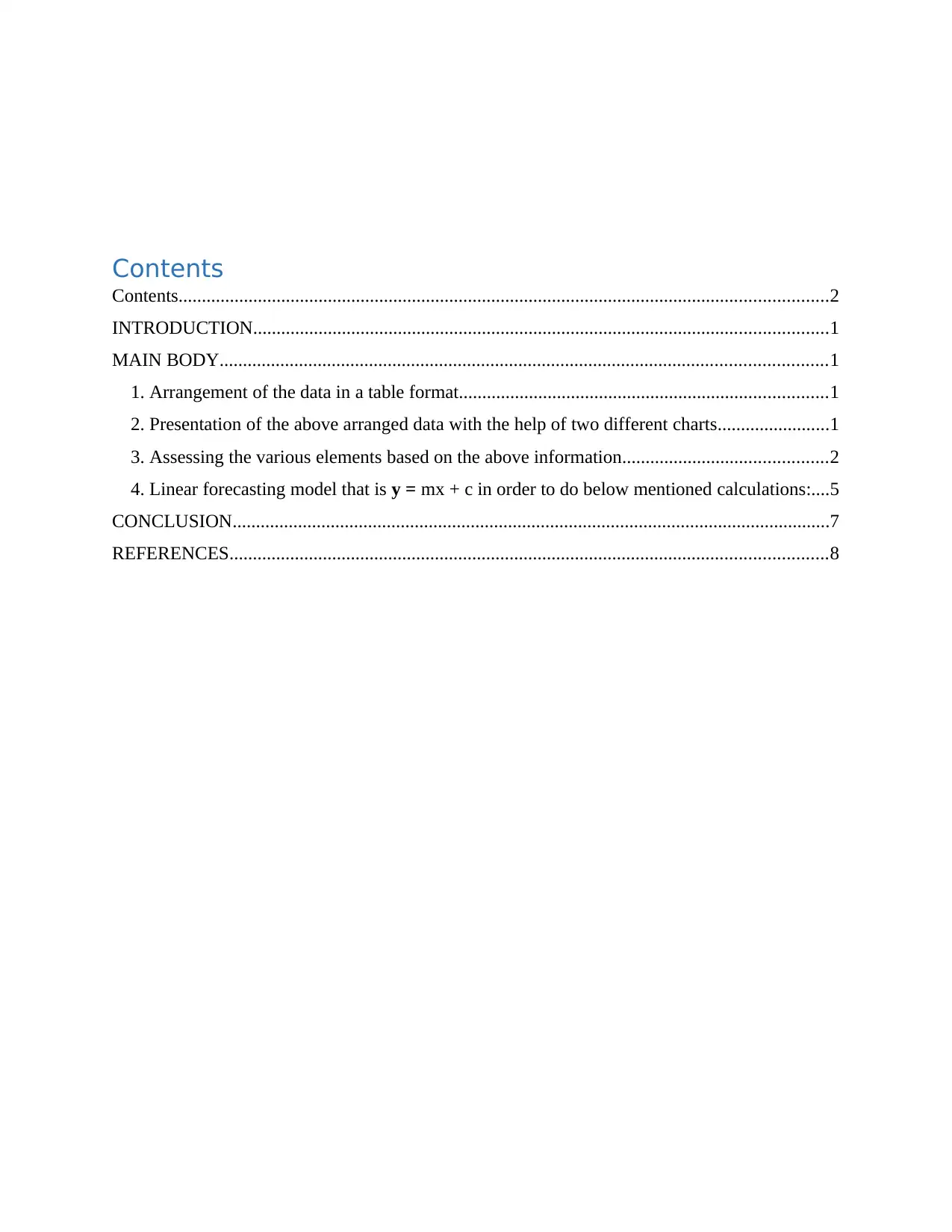
Contents
Contents...........................................................................................................................................2
INTRODUCTION...........................................................................................................................1
MAIN BODY..................................................................................................................................1
1. Arrangement of the data in a table format...............................................................................1
2. Presentation of the above arranged data with the help of two different charts........................1
3. Assessing the various elements based on the above information............................................2
4. Linear forecasting model that is y = mx + c in order to do below mentioned calculations:....5
CONCLUSION................................................................................................................................7
REFERENCES................................................................................................................................8
Contents...........................................................................................................................................2
INTRODUCTION...........................................................................................................................1
MAIN BODY..................................................................................................................................1
1. Arrangement of the data in a table format...............................................................................1
2. Presentation of the above arranged data with the help of two different charts........................1
3. Assessing the various elements based on the above information............................................2
4. Linear forecasting model that is y = mx + c in order to do below mentioned calculations:....5
CONCLUSION................................................................................................................................7
REFERENCES................................................................................................................................8

⊘ This is a preview!⊘
Do you want full access?
Subscribe today to unlock all pages.

Trusted by 1+ million students worldwide
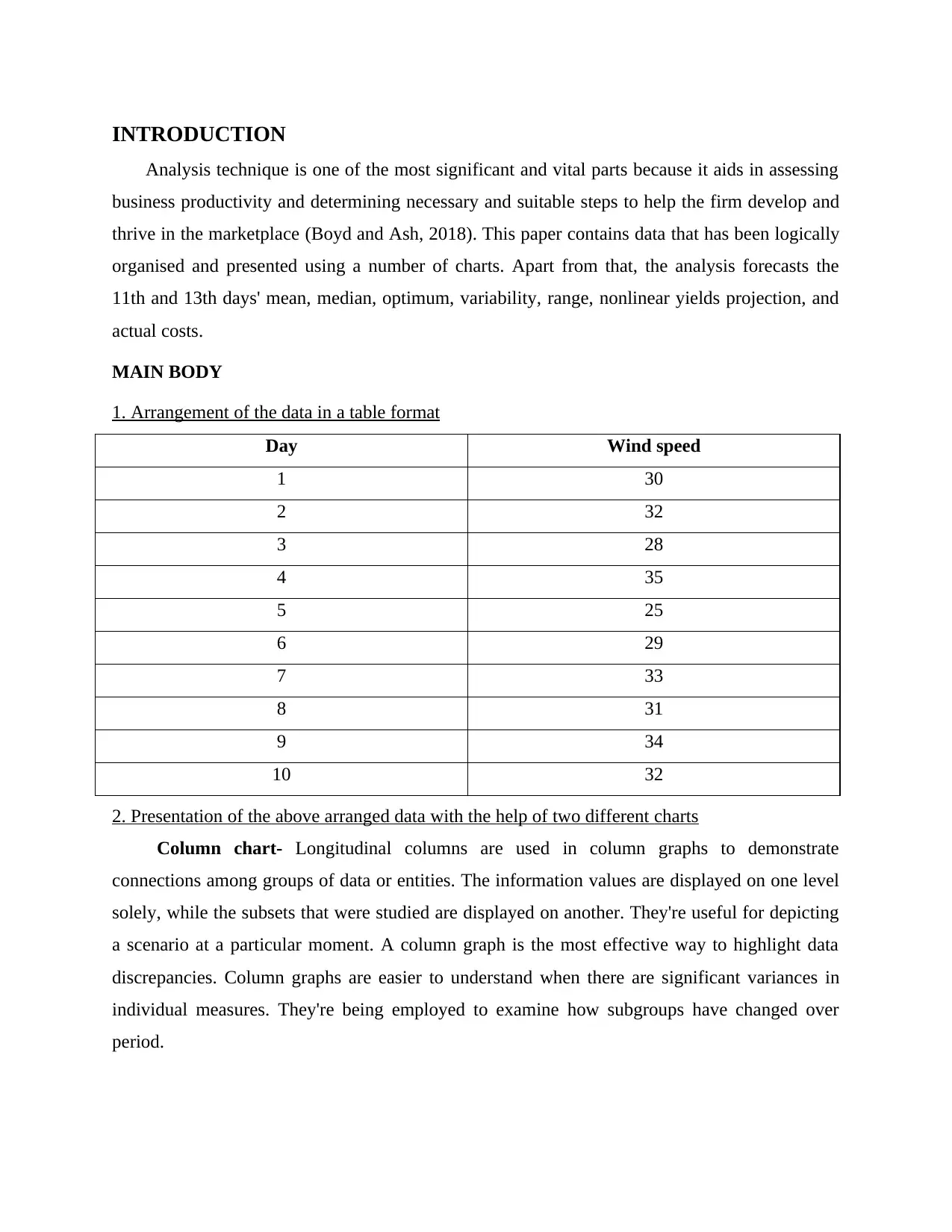
INTRODUCTION
Analysis technique is one of the most significant and vital parts because it aids in assessing
business productivity and determining necessary and suitable steps to help the firm develop and
thrive in the marketplace (Boyd and Ash, 2018). This paper contains data that has been logically
organised and presented using a number of charts. Apart from that, the analysis forecasts the
11th and 13th days' mean, median, optimum, variability, range, nonlinear yields projection, and
actual costs.
MAIN BODY
1. Arrangement of the data in a table format
Day Wind speed
1 30
2 32
3 28
4 35
5 25
6 29
7 33
8 31
9 34
10 32
2. Presentation of the above arranged data with the help of two different charts
Column chart- Longitudinal columns are used in column graphs to demonstrate
connections among groups of data or entities. The information values are displayed on one level
solely, while the subsets that were studied are displayed on another. They're useful for depicting
a scenario at a particular moment. A column graph is the most effective way to highlight data
discrepancies. Column graphs are easier to understand when there are significant variances in
individual measures. They're being employed to examine how subgroups have changed over
period.
Analysis technique is one of the most significant and vital parts because it aids in assessing
business productivity and determining necessary and suitable steps to help the firm develop and
thrive in the marketplace (Boyd and Ash, 2018). This paper contains data that has been logically
organised and presented using a number of charts. Apart from that, the analysis forecasts the
11th and 13th days' mean, median, optimum, variability, range, nonlinear yields projection, and
actual costs.
MAIN BODY
1. Arrangement of the data in a table format
Day Wind speed
1 30
2 32
3 28
4 35
5 25
6 29
7 33
8 31
9 34
10 32
2. Presentation of the above arranged data with the help of two different charts
Column chart- Longitudinal columns are used in column graphs to demonstrate
connections among groups of data or entities. The information values are displayed on one level
solely, while the subsets that were studied are displayed on another. They're useful for depicting
a scenario at a particular moment. A column graph is the most effective way to highlight data
discrepancies. Column graphs are easier to understand when there are significant variances in
individual measures. They're being employed to examine how subgroups have changed over
period.
Paraphrase This Document
Need a fresh take? Get an instant paraphrase of this document with our AI Paraphraser
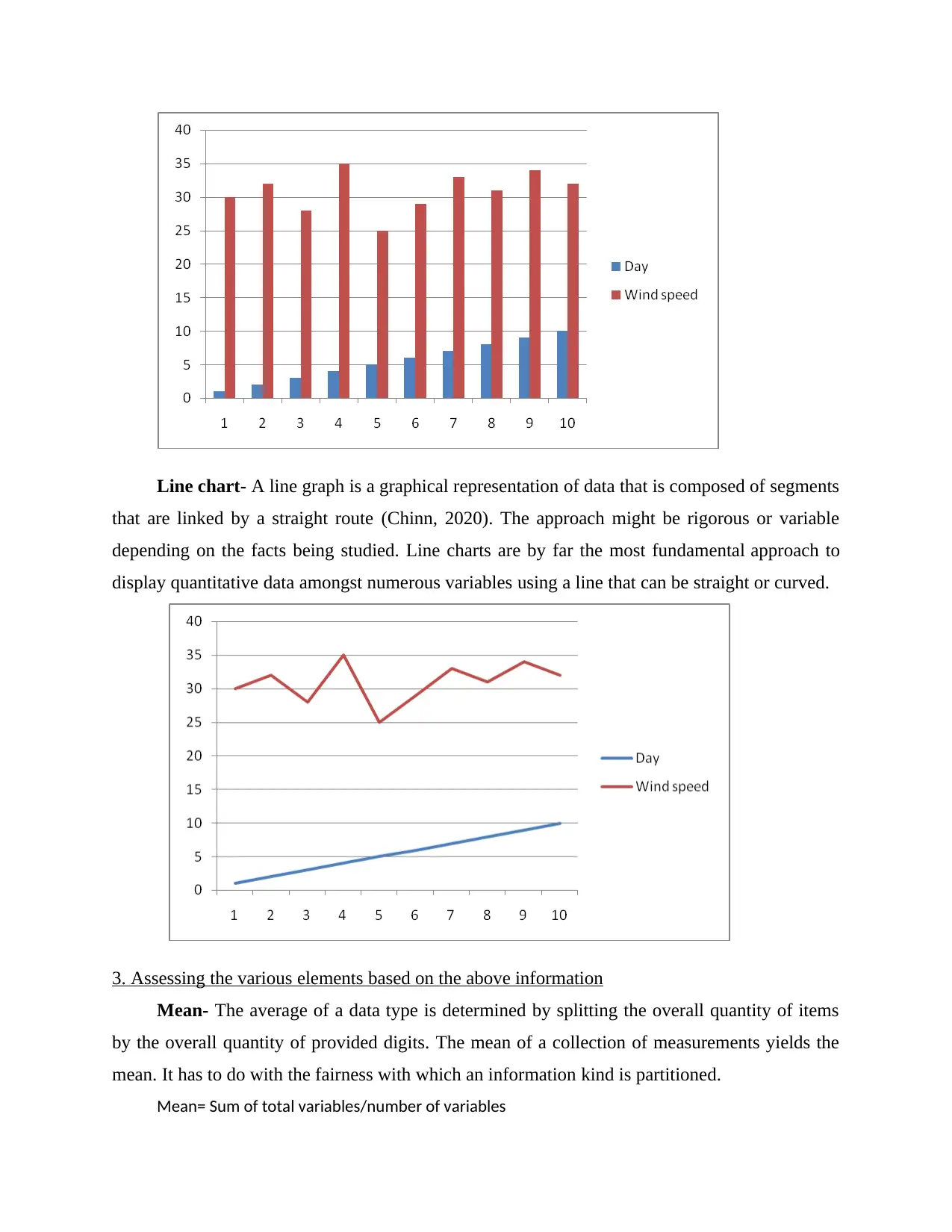
Line chart- A line graph is a graphical representation of data that is composed of segments
that are linked by a straight route (Chinn, 2020). The approach might be rigorous or variable
depending on the facts being studied. Line charts are by far the most fundamental approach to
display quantitative data amongst numerous variables using a line that can be straight or curved.
3. Assessing the various elements based on the above information
Mean- The average of a data type is determined by splitting the overall quantity of items
by the overall quantity of provided digits. The mean of a collection of measurements yields the
mean. It has to do with the fairness with which an information kind is partitioned.
Mean= Sum of total variables/number of variables
that are linked by a straight route (Chinn, 2020). The approach might be rigorous or variable
depending on the facts being studied. Line charts are by far the most fundamental approach to
display quantitative data amongst numerous variables using a line that can be straight or curved.
3. Assessing the various elements based on the above information
Mean- The average of a data type is determined by splitting the overall quantity of items
by the overall quantity of provided digits. The mean of a collection of measurements yields the
mean. It has to do with the fairness with which an information kind is partitioned.
Mean= Sum of total variables/number of variables
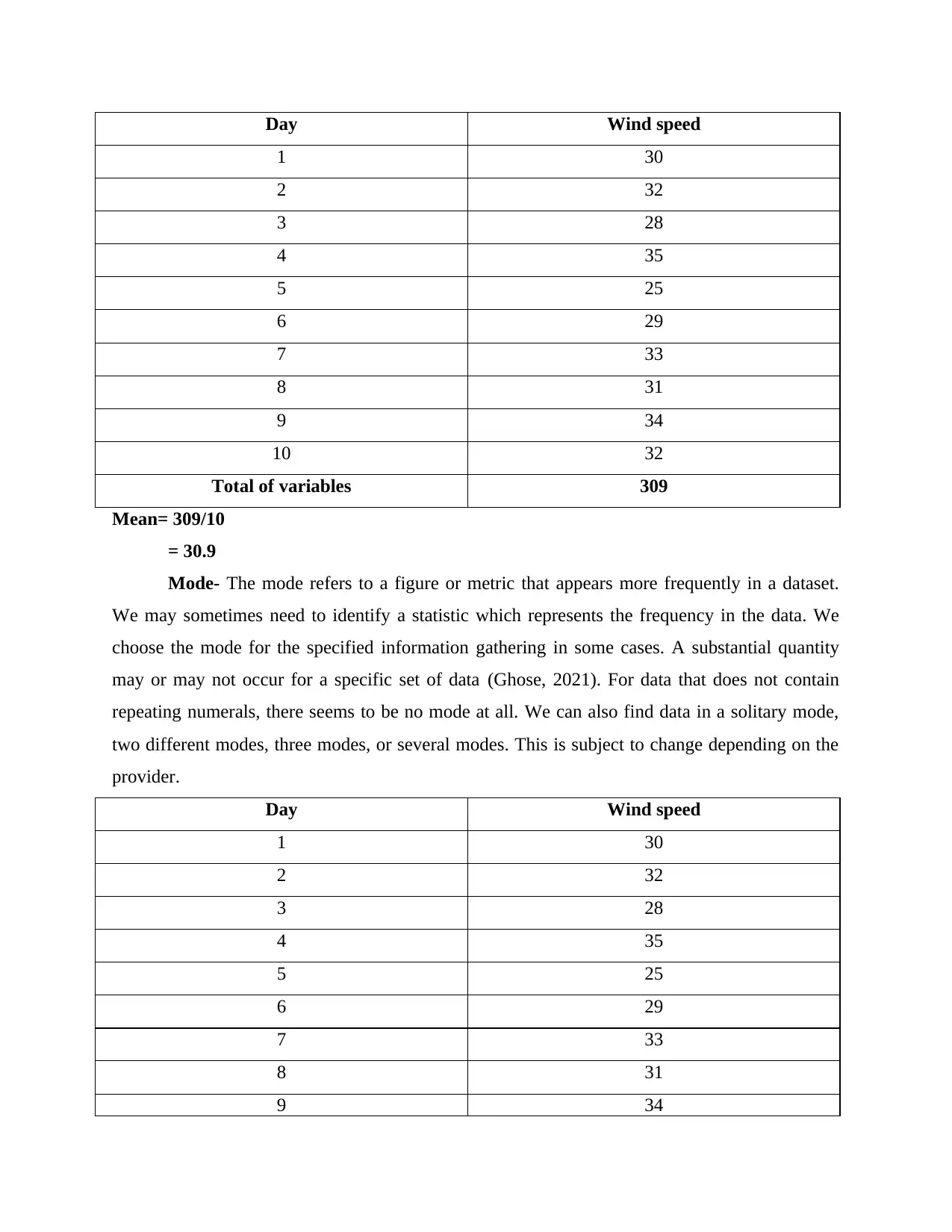
Day Wind speed
1 30
2 32
3 28
4 35
5 25
6 29
7 33
8 31
9 34
10 32
Total of variables 309
Mean= 309/10
= 30.9
Mode- The mode refers to a figure or metric that appears more frequently in a dataset.
We may sometimes need to identify a statistic which represents the frequency in the data. We
choose the mode for the specified information gathering in some cases. A substantial quantity
may or may not occur for a specific set of data (Ghose, 2021). For data that does not contain
repeating numerals, there seems to be no mode at all. We can also find data in a solitary mode,
two different modes, three modes, or several modes. This is subject to change depending on the
provider.
Day Wind speed
1 30
2 32
3 28
4 35
5 25
6 29
7 33
8 31
9 34
1 30
2 32
3 28
4 35
5 25
6 29
7 33
8 31
9 34
10 32
Total of variables 309
Mean= 309/10
= 30.9
Mode- The mode refers to a figure or metric that appears more frequently in a dataset.
We may sometimes need to identify a statistic which represents the frequency in the data. We
choose the mode for the specified information gathering in some cases. A substantial quantity
may or may not occur for a specific set of data (Ghose, 2021). For data that does not contain
repeating numerals, there seems to be no mode at all. We can also find data in a solitary mode,
two different modes, three modes, or several modes. This is subject to change depending on the
provider.
Day Wind speed
1 30
2 32
3 28
4 35
5 25
6 29
7 33
8 31
9 34
⊘ This is a preview!⊘
Do you want full access?
Subscribe today to unlock all pages.

Trusted by 1+ million students worldwide
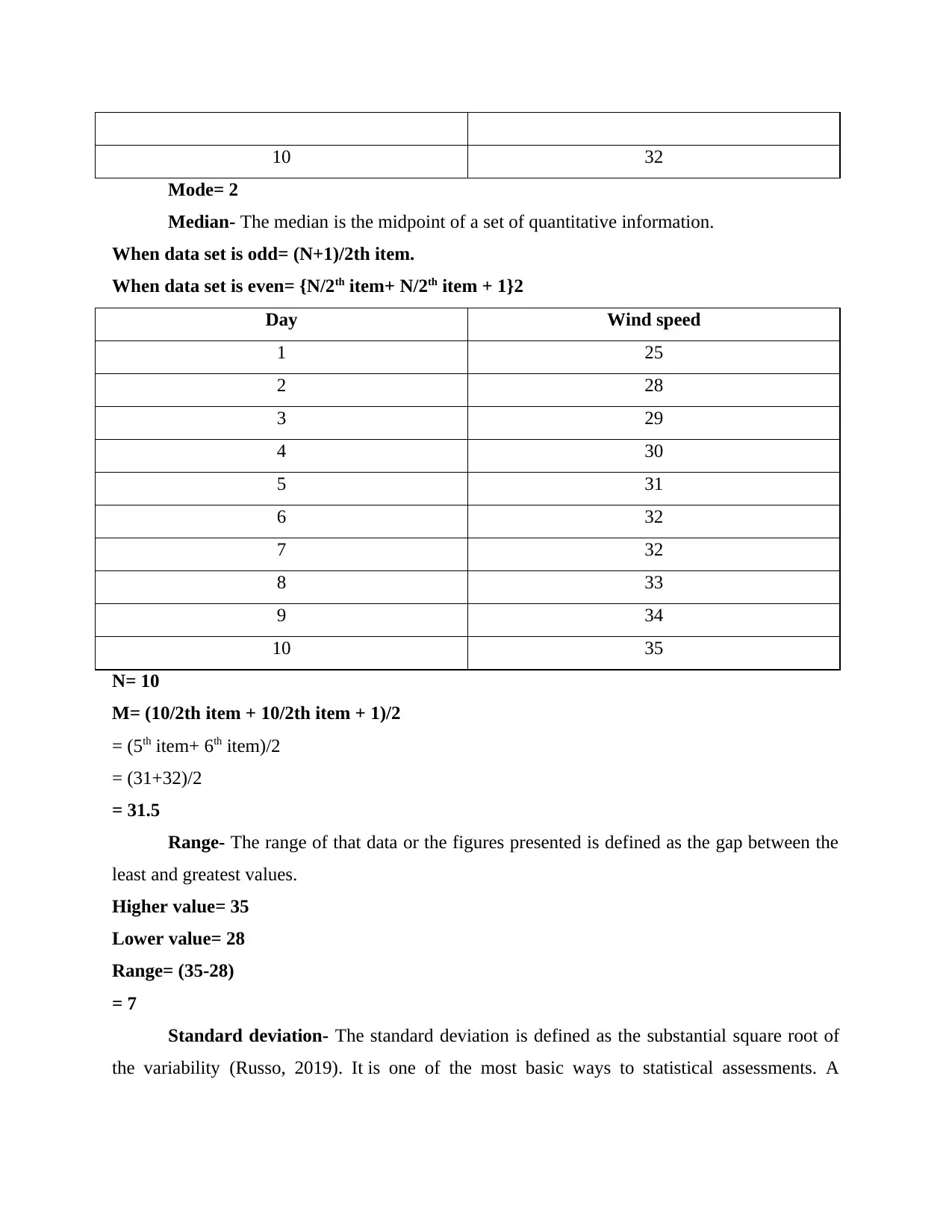
10 32
Mode= 2
Median- The median is the midpoint of a set of quantitative information.
When data set is odd= (N+1)/2th item.
When data set is even= {N/2th item+ N/2th item + 1}2
Day Wind speed
1 25
2 28
3 29
4 30
5 31
6 32
7 32
8 33
9 34
10 35
N= 10
M= (10/2th item + 10/2th item + 1)/2
= (5th item+ 6th item)/2
= (31+32)/2
= 31.5
Range- The range of that data or the figures presented is defined as the gap between the
least and greatest values.
Higher value= 35
Lower value= 28
Range= (35-28)
= 7
Standard deviation- The standard deviation is defined as the substantial square root of
the variability (Russo, 2019). It is one of the most basic ways to statistical assessments. A
Mode= 2
Median- The median is the midpoint of a set of quantitative information.
When data set is odd= (N+1)/2th item.
When data set is even= {N/2th item+ N/2th item + 1}2
Day Wind speed
1 25
2 28
3 29
4 30
5 31
6 32
7 32
8 33
9 34
10 35
N= 10
M= (10/2th item + 10/2th item + 1)/2
= (5th item+ 6th item)/2
= (31+32)/2
= 31.5
Range- The range of that data or the figures presented is defined as the gap between the
least and greatest values.
Higher value= 35
Lower value= 28
Range= (35-28)
= 7
Standard deviation- The standard deviation is defined as the substantial square root of
the variability (Russo, 2019). It is one of the most basic ways to statistical assessments. A
Paraphrase This Document
Need a fresh take? Get an instant paraphrase of this document with our AI Paraphraser
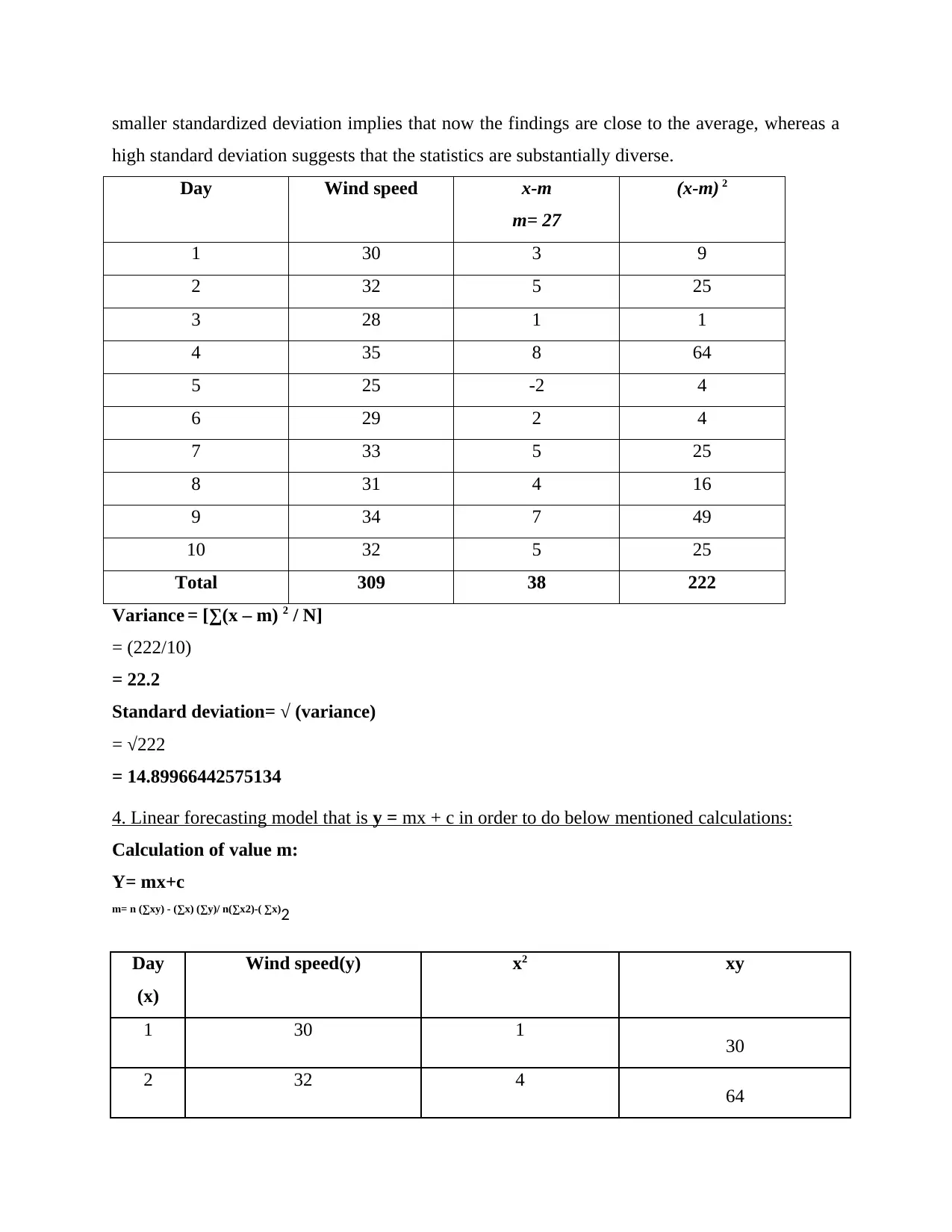
smaller standardized deviation implies that now the findings are close to the average, whereas a
high standard deviation suggests that the statistics are substantially diverse.
Day Wind speed x-m
m= 27
(x-m) 2
1 30 3 9
2 32 5 25
3 28 1 1
4 35 8 64
5 25 -2 4
6 29 2 4
7 33 5 25
8 31 4 16
9 34 7 49
10 32 5 25
Total 309 38 222
Variance = [∑(x – m) 2 / N]
= (222/10)
= 22.2
Standard deviation= √ (variance)
= √222
= 14.89966442575134
4. Linear forecasting model that is y = mx + c in order to do below mentioned calculations:
Calculation of value m:
Y= mx+c
m= n (∑xy) - (∑x) (∑y)/ n(∑x2)-( ∑x)2
Day
(x)
Wind speed(y) x2 xy
1 30 1 30
2 32 4 64
high standard deviation suggests that the statistics are substantially diverse.
Day Wind speed x-m
m= 27
(x-m) 2
1 30 3 9
2 32 5 25
3 28 1 1
4 35 8 64
5 25 -2 4
6 29 2 4
7 33 5 25
8 31 4 16
9 34 7 49
10 32 5 25
Total 309 38 222
Variance = [∑(x – m) 2 / N]
= (222/10)
= 22.2
Standard deviation= √ (variance)
= √222
= 14.89966442575134
4. Linear forecasting model that is y = mx + c in order to do below mentioned calculations:
Calculation of value m:
Y= mx+c
m= n (∑xy) - (∑x) (∑y)/ n(∑x2)-( ∑x)2
Day
(x)
Wind speed(y) x2 xy
1 30 1 30
2 32 4 64
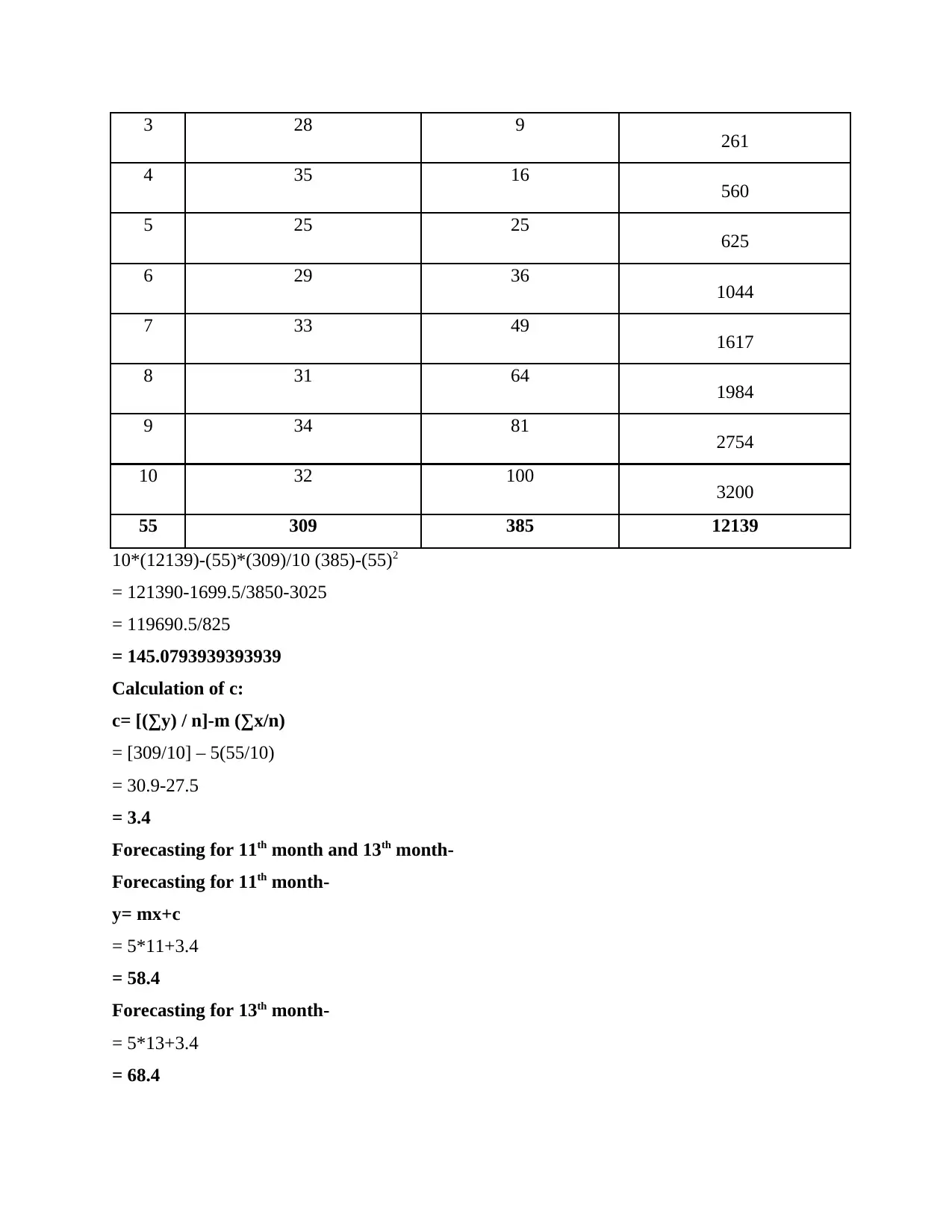
3 28 9 261
4 35 16 560
5 25 25 625
6 29 36 1044
7 33 49 1617
8 31 64 1984
9 34 81 2754
10 32 100 3200
55 309 385 12139
10*(12139)-(55)*(309)/10 (385)-(55)2
= 121390-1699.5/3850-3025
= 119690.5/825
= 145.0793939393939
Calculation of c:
c= [(∑y) / n]-m (∑x/n)
= [309/10] – 5(55/10)
= 30.9-27.5
= 3.4
Forecasting for 11th month and 13th month-
Forecasting for 11th month-
y= mx+c
= 5*11+3.4
= 58.4
Forecasting for 13th month-
= 5*13+3.4
= 68.4
4 35 16 560
5 25 25 625
6 29 36 1044
7 33 49 1617
8 31 64 1984
9 34 81 2754
10 32 100 3200
55 309 385 12139
10*(12139)-(55)*(309)/10 (385)-(55)2
= 121390-1699.5/3850-3025
= 119690.5/825
= 145.0793939393939
Calculation of c:
c= [(∑y) / n]-m (∑x/n)
= [309/10] – 5(55/10)
= 30.9-27.5
= 3.4
Forecasting for 11th month and 13th month-
Forecasting for 11th month-
y= mx+c
= 5*11+3.4
= 58.4
Forecasting for 13th month-
= 5*13+3.4
= 68.4
⊘ This is a preview!⊘
Do you want full access?
Subscribe today to unlock all pages.

Trusted by 1+ million students worldwide
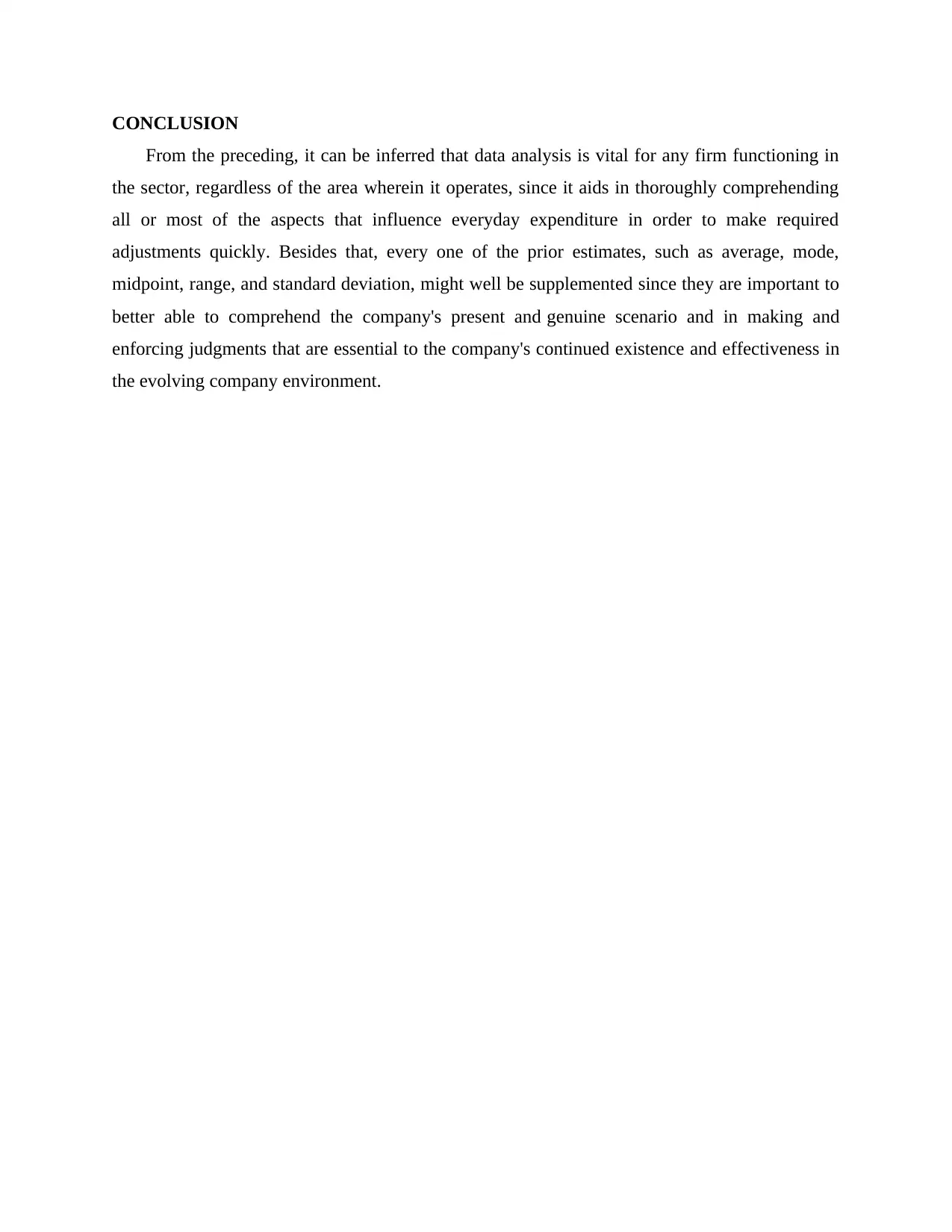
CONCLUSION
From the preceding, it can be inferred that data analysis is vital for any firm functioning in
the sector, regardless of the area wherein it operates, since it aids in thoroughly comprehending
all or most of the aspects that influence everyday expenditure in order to make required
adjustments quickly. Besides that, every one of the prior estimates, such as average, mode,
midpoint, range, and standard deviation, might well be supplemented since they are important to
better able to comprehend the company's present and genuine scenario and in making and
enforcing judgments that are essential to the company's continued existence and effectiveness in
the evolving company environment.
From the preceding, it can be inferred that data analysis is vital for any firm functioning in
the sector, regardless of the area wherein it operates, since it aids in thoroughly comprehending
all or most of the aspects that influence everyday expenditure in order to make required
adjustments quickly. Besides that, every one of the prior estimates, such as average, mode,
midpoint, range, and standard deviation, might well be supplemented since they are important to
better able to comprehend the company's present and genuine scenario and in making and
enforcing judgments that are essential to the company's continued existence and effectiveness in
the evolving company environment.
Paraphrase This Document
Need a fresh take? Get an instant paraphrase of this document with our AI Paraphraser
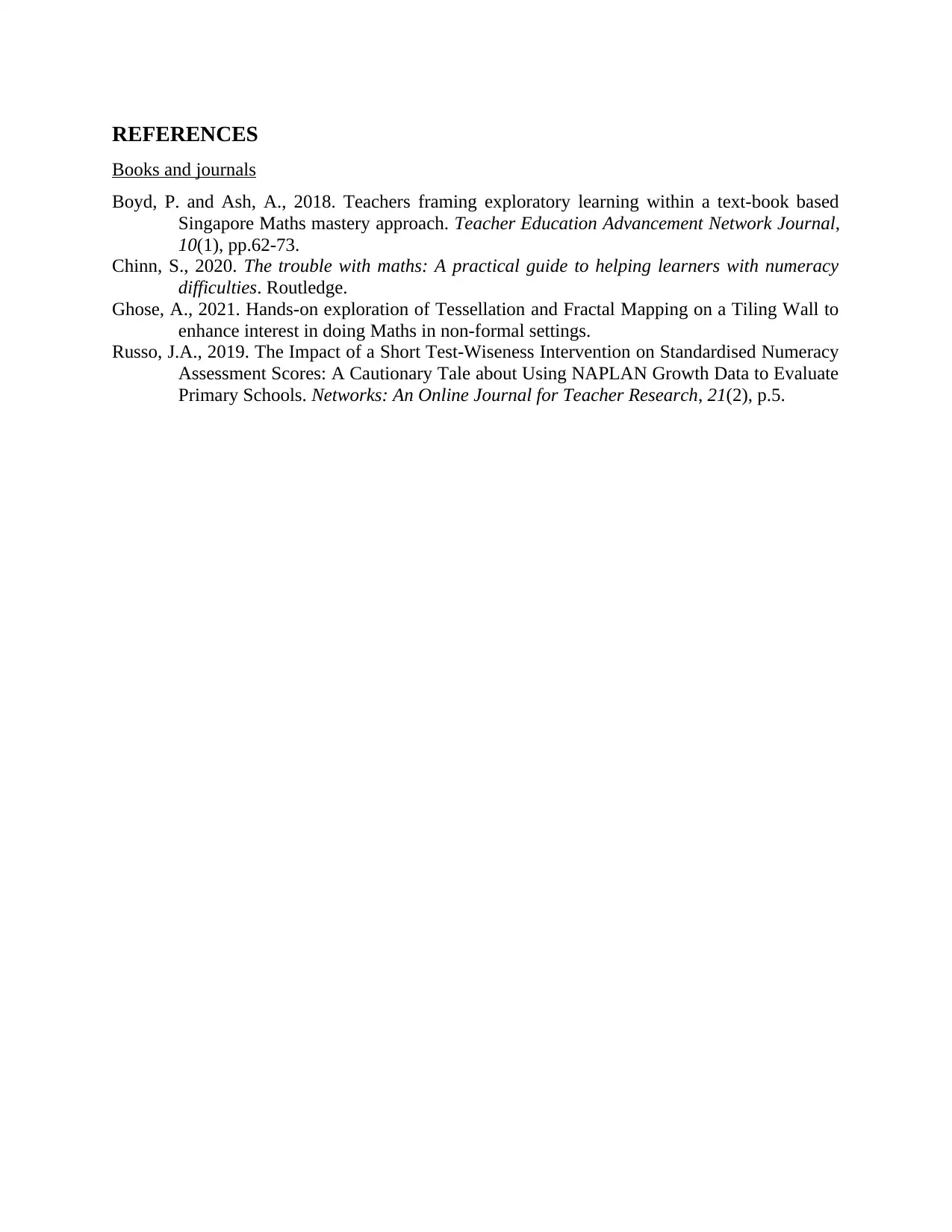
REFERENCES
Books and journals
Boyd, P. and Ash, A., 2018. Teachers framing exploratory learning within a text-book based
Singapore Maths mastery approach. Teacher Education Advancement Network Journal,
10(1), pp.62-73.
Chinn, S., 2020. The trouble with maths: A practical guide to helping learners with numeracy
difficulties. Routledge.
Ghose, A., 2021. Hands-on exploration of Tessellation and Fractal Mapping on a Tiling Wall to
enhance interest in doing Maths in non-formal settings.
Russo, J.A., 2019. The Impact of a Short Test-Wiseness Intervention on Standardised Numeracy
Assessment Scores: A Cautionary Tale about Using NAPLAN Growth Data to Evaluate
Primary Schools. Networks: An Online Journal for Teacher Research, 21(2), p.5.
Books and journals
Boyd, P. and Ash, A., 2018. Teachers framing exploratory learning within a text-book based
Singapore Maths mastery approach. Teacher Education Advancement Network Journal,
10(1), pp.62-73.
Chinn, S., 2020. The trouble with maths: A practical guide to helping learners with numeracy
difficulties. Routledge.
Ghose, A., 2021. Hands-on exploration of Tessellation and Fractal Mapping on a Tiling Wall to
enhance interest in doing Maths in non-formal settings.
Russo, J.A., 2019. The Impact of a Short Test-Wiseness Intervention on Standardised Numeracy
Assessment Scores: A Cautionary Tale about Using NAPLAN Growth Data to Evaluate
Primary Schools. Networks: An Online Journal for Teacher Research, 21(2), p.5.
1 out of 11
Related Documents
Your All-in-One AI-Powered Toolkit for Academic Success.
+13062052269
info@desklib.com
Available 24*7 on WhatsApp / Email
![[object Object]](/_next/static/media/star-bottom.7253800d.svg)
Unlock your academic potential
© 2024 | Zucol Services PVT LTD | All rights reserved.


